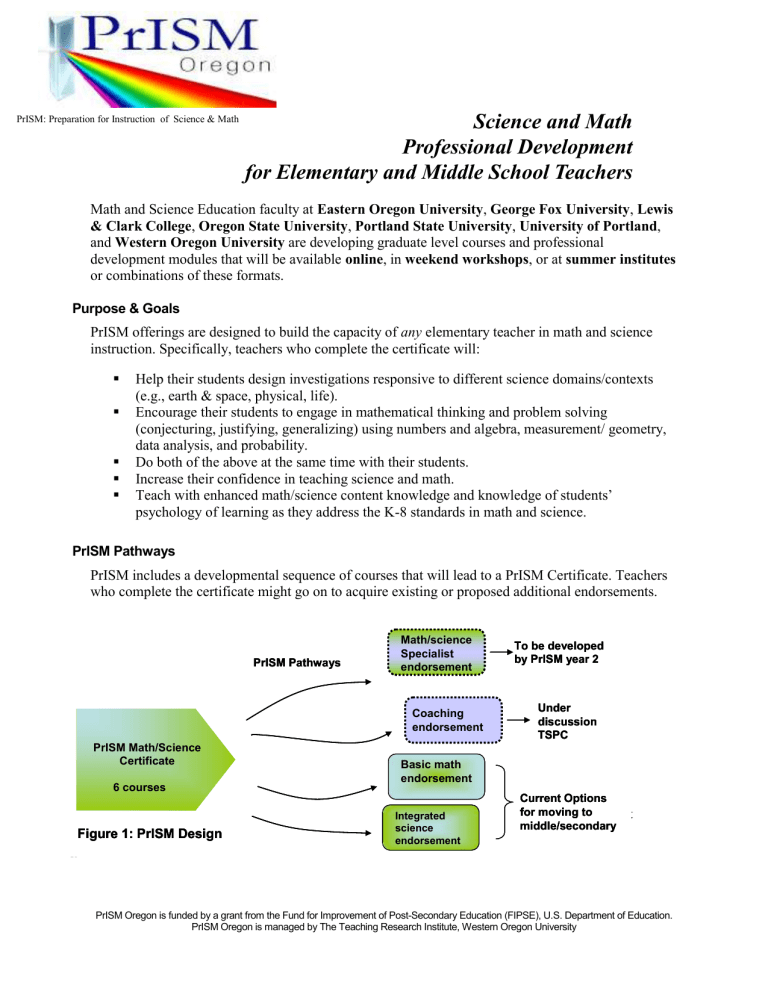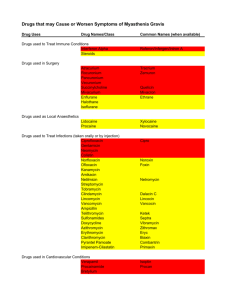Science and Math Professional Development for Elementary and

PrISM: Preparation for Instruction of Science & Math
Science and Math
Professional Development for Elementary and Middle School Teachers
Math and Science Education faculty at Eastern Oregon University , George Fox University , Lewis
& Clark College , Oregon State University , Portland State University , University of Portland , and Western Oregon University are developing graduate level courses and professional development modules that will be available online , in weekend workshops , or at summer institutes or combinations of these formats.
Purpose & Goals
PrISM offerings are designed to build the capacity of any elementary teacher in math and science instruction. Specifically, teachers who complete the certificate will:
Help their students design investigations responsive to different science domains/contexts
(e.g., earth & space, physical, life).
Encourage their students to engage in mathematical thinking and problem solving
(conjecturing, justifying, generalizing) using numbers and algebra, measurement/ geometry, data analysis, and probability.
Do both of the above at the same time with their students.
Increase their confidence in teaching science and math.
Teach with enhanced math/science content knowledge and knowledge of students’ psychology of learning as they address the K-8 standards in math and science.
PrISM Pathways
PrISM includes a developmental sequence of courses that will lead to a PrISM Certificate. Teachers who complete the certificate might go on to acquire existing or proposed additional endorsements.
Course Organization and Design
PrISM Curriculum Design & Structure
PrISM courses are based on the following four themes. Different courses may emphasize different themes, but a brief overview of the four themes will be embedded in all courses. v
PrISM Oregon is funded by a grant from the Fund for Improvement of Post-Secondary Education (FIPSE), U.S. Department of Education.
PrISM Oregon is managed by The Teaching Research Institute, Western Oregon University
Curriculum Design Themes
All course work is designed to develop critical skills and knowledge through the following themes.
Place-Based Education. Curriculum and instruction that helps students develop a “sense of place” by focusing teaching on exploration of the local environment, culture, and community. Students learn to inquire about their own world, thus relating curricular content to student lives in more meaningful ways. Students also better understand and contribute to their families and local communities
Multiple Literacies. Literacy involves apprenticeship in the discourse practices and ways of knowing in social communities. These discourses include language, as well as identities, relationships, values, intentions and various other modes of communication, media, and technology.
Individuals are members of many different discourse communities throughout their life span. This vision of multiple literacies will guide the development of math/science curriculum and coursework for English language learners and members of other marginalized groups. Teachers will explore their own literacies in preparation for understanding and fostering the literacies of their students across all parts of the curriculum.
Integrating Math and Science across the Curriculum. Science and mathematics are embedded in multiple aspects of living and learning. They regularly form the content of popular culture, major social issues, and is fundamental in decision-making for purchasing, voting, vacationing, leisure time, and everyday finances. Scientific and mathematical knowledge must be put to use in all aspects of the curriculum in order to make it a living knowledge.
Integrated Math/Science Preparation. Similarly, all PrISM courses will integrate the teaching of math and science both for inservice teachers’ courses and as a core principle for teachers to use in designing math and science instruction for K-8 students. In this way, students will experience these disciplines not as a set of rules or algorithms to be memorized, but rather as tools for thinking and discovery in their own lives and communities.
PrISM courses can be compiled across any of the seven partner institutions and will be either 3 quarter hours or 2 semester hours and have a common tuition. The PrISM certificate requires teachers to complete the sequence of coursework that includes building capacity in math and science content. The introductory course will not be a prerequisite to other PrISM courses. However, teachers will be encouraged to begin with the introductory course especially if they lack confidence in teaching math or science or if their content preparation backgrounds are modest. The last course in the sequence for all teachers completing the PrISM certificate will be the PrISM Capstone Course.
PrISM Oregon courses will be available in spring quarter and summer term, 2008. Watch for further notices at http://prismoregon.org
Questions? Contact Dianne Ferguson diannef@comcast.net
or fergusod@wou.edu
Bonnie Morihara moriharb@wou.edu







